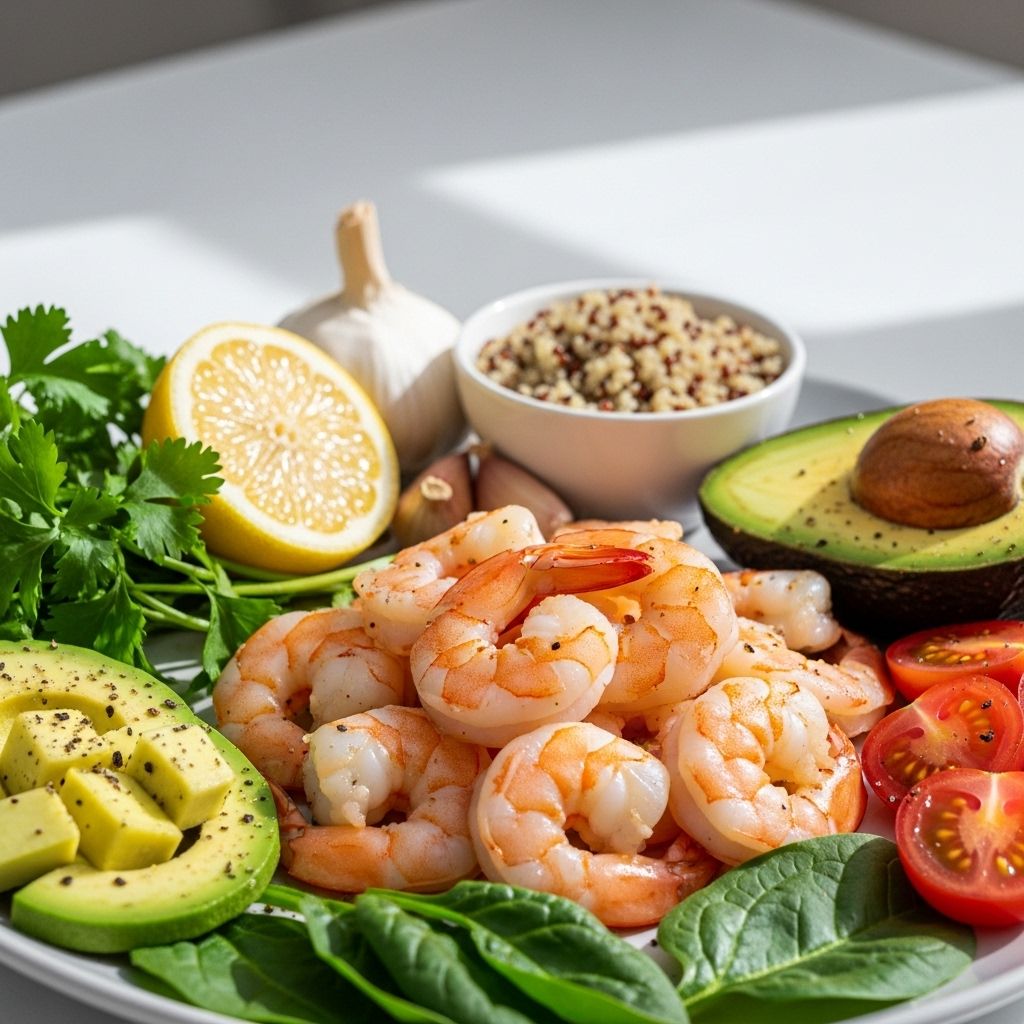Shrimp Benefits: Nutrition, Health Impact, and Culinary Insights
These seafood favorites offer lean protein, astaxanthin, and key minerals.

Introduction
Shrimp, cherished worldwide for its delicate texture and flavor, is not only a crowd-pleasing delicacy but also a powerhouse of nutrition. Whether grilled, boiled, sautéed, or poached, these tiny crustaceans pack a punch in terms of protein, essential minerals, and health-boosting compounds. However, controversies about cholesterol and farming practices linger. This article explores shrimp’s benefits, nutritional facts, health impacts, possible risks, and expert guidance on including shrimp in a healthy diet.
What Is Shrimp?
Shrimp are small, aquatic crustaceans commonly found in both salt and freshwater bodies. They are consumed globally and esteemed in cuisines ranging from Mediterranean to Asian. Characterized by their slender bodies and flexible abdomen, shrimp offer a mild, sweet taste and easily absorb flavors from herbs and spices.
Shrimp Nutrition Facts
| Nutrient (per 100g cooked shrimp) | Amount |
|---|---|
| Calories | 84–99 kcal |
| Protein | 20–24 g |
| Fat | 0.3 g |
| Carbohydrates | 0.2 g |
| Cholesterol | 189 mg |
| Sodium | 94–111 mg |
| Omega-3 Fatty Acids | ~0.3 g |
| Iodine | High |
| Vitamin B12 | Significant source |
| Other Minerals | Iron, Magnesium, Zinc, Selenium, Phosphorus, Copper |
*Values are approximate and may vary by source and preparation method.
Key Health Benefits of Shrimp
- Rich Protein Source: Shrimp is a lean protein, with a 3-ounce (85-gram) serving providing roughly 20 grams of protein, making it an excellent option for maintaining muscle mass and promoting satiety.
- Low Calorie Content: With only about 84 to 99 calories per serving, shrimp supports weight management and helps maintain a lower calorie intake compared to many other protein sources.
- Essential Vitamins and Minerals: Shrimp is loaded with nutrients that are often deficient in modern diets, including iodine, selenium, zinc, magnesium, phosphorus, copper, and vitamin B12. These are crucial for thyroid health, blood formation, immune function, and healthy metabolism.
- Omega-3 Fatty Acids: Although shrimp is not as high in omega-3s as fatty fish, it provides a useful amount of EPA and DHA, both known to promote cardiovascular and cognitive health.
- Antioxidant Power – Astaxanthin: Shrimp contains astaxanthin, a potent red-colored antioxidant that fights inflammation, supports skin health, and may help reduce the risk of neurodegenerative and heart diseases.
- Low in Saturated Fat: Most of the very small amount of fat found in shrimp is unsaturated, making it favorable when compared to many other animal-based proteins.
- Potential Disease Prevention: Thanks to a unique mix of nutrients and antioxidants, regular shrimp consumption may help lower the risk of chronic diseases such as heart disease, certain cancers, and thyroid disorders.
Detailed Examination of Shrimp’s Nutrient Benefits
1. Iodine for Thyroid and Brain Health
Iodine is essential for thyroid hormone production and proper neurological development. Shrimp is among the few foods naturally rich in iodine. A diet lacking in iodine can cause thyroid dysfunction and cognitive decline. Including shrimp may help prevent deficiencies, especially in populations with low seafood intake.
2. Selenium: Immunity and Cell Protection
Selenium is a powerful mineral antioxidant found in shrimp. It helps protect cells from oxidative damage, supports thyroid hormone metabolism, and enhances immune defenses. Some research suggests selenium intake may offer cancer-protective effects.
3. Astaxanthin Antioxidant
Shrimp’s pink color comes from astaxanthin, a marine antioxidant. Astaxanthin helps shield the nervous system, protect the eyes from sun damage, and reduce inflammation throughout the body. It is currently being studied for its role in slowing age-related decline and supporting heart and brain health.
4. Heart-Healthy Fats and Cholesterol
Shrimp contains a moderate amount of cholesterol (about 189 mg per 100 grams). While older dietary advice recommended limiting cholesterol intake, current science indicates dietary cholesterol (as from shrimp) has much less impact on blood cholesterol levels than previously believed. Instead, saturated and trans fats play a larger role. The omega-3 fatty acids present in shrimp further support cardiovascular health by reducing blood triglycerides and inflammation.
Addressing Common Concerns and Misconceptions
1. Shrimp and Cholesterol: Should You Worry?
Though shrimp is high in cholesterol, studies increasingly show it does not significantly raise LDL or total cholesterol levels for most healthy individuals. Instead, it is low in saturated fat, which is more closely linked to unhealthy cholesterol levels. For most people without existing heart disease or cholesterol sensitivity, moderate shrimp intake is safe and even beneficial.
2. Allergies and Intolerances
Shrimp is among the top eight food allergens globally. Reactions can range from mild to life-threatening and may include hives, swelling, digestive distress, or anaphylaxis. People with shellfish allergy should completely avoid shrimp and related crustaceans. Always check for allergy signs before trying shrimp for the first time.
3. Antibiotics and Contaminants in Farmed Shrimp
Some farm-raised shrimp may be exposed to antibiotics, unregulated chemicals, or poor farming practices. Wild-caught or certified sustainable farmed shrimp are often preferable to reduce exposure to potential environmental toxins. Mercury content in shrimp is typically low because they are low on the aquatic food chain, making them a safer seafood option.
Healthy Ways to Prepare Shrimp
- Baking: Retains nutrients and uses little to no fat.
- Boiling: Simple, fast, and requires no added fat.
- Grilling: Enhances flavor without extra calories.
- Poaching: Gentle cooking reduces toughening and helps retain minerals.
- Sautéing: Use healthy oils such as olive or avocado oil for added heart benefits.
- Steaming: Preserves texture and keeps shrimp moist.
Avoid deep-frying, breading, or cooking with heavy sauces to keep shrimp as healthy as possible. Pair with fresh vegetables, whole grains, and herbs for a nutrient-packed meal.
Tips for Selecting and Storing Shrimp
- Choose wild-caught or certified sustainable shrimp when available.
- Look for firm, translucent flesh if buying raw shrimp; avoid those with a strong ammonia odor.
- If purchasing frozen, select shrimp that are flash-frozen soon after harvest and check for intact shells.
- Consume cooked shrimp within 2-3 days of preparation for best quality and safety.
Risks and Precautions
- Shellfish Allergy: Can cause severe and rapid reactions; complete avoidance is necessary for affected individuals.
- Food Safety: Under-cooked or improperly handled shrimp may harbor harmful bacteria; always cook thoroughly.
- Cholesterol Concerns: Individuals with existing heart conditions or specific dietary restrictions should consult healthcare professionals before significantly increasing shrimp intake.
- Sustainability: Overfishing and poorly managed shrimp farms can harm ecosystems. Preferably choose certified or wild-caught supplies.
Comparing Shrimp to Other Protein Sources
| Protein Source (per 3 oz) | Calories | Protein | Total Fat | Cholesterol |
|---|---|---|---|---|
| Shrimp | ~84 | 20 g | <1 g | 161 mg |
| Chicken (skinless) | 140 | 26 g | 3 g | 73 mg |
| Salmon | 155 | 21 g | 7 g | 63 mg |
| Sirloin Beef | 207 | 23 g | 13 g | 76 mg |
Shrimp stands out for its low calories and fat, while providing a comparable amount of protein to other animal sources.
Frequently Asked Questions (FAQs)
Q: How often can I safely eat shrimp?
A: Most healthy adults can enjoy shrimp as part of a balanced diet two to three times per week, provided they have no shellfish allergy and follow responsible sourcing and preparation guidelines.
Q: Does shrimp raise cholesterol levels?
A: Shrimp is high in cholesterol, but for most people, eating shrimp in moderation does not significantly impact blood cholesterol or heart disease risk, due to its low saturated fat content and the presence of beneficial omega-3 fatty acids.
Q: Is it better to eat wild-caught or farmed shrimp?
A: Wild-caught shrimp are generally lower in potential contaminants and antibiotics. However, sustainably farmed shrimp certified by reputable organizations can also be a safe choice. Review labels and ask your fishmonger for sourcing details.
Q: Are there downsides to eating shrimp?
A: Main concerns are shellfish allergy, contaminants in poorly farmed shrimp, and dietary cholesterol for individuals with certain health conditions. Choosing high-quality products and cooking shrimp properly mitigates most risks.
Q: What are healthy ways to cook shrimp?
A: Opt for boiling, steaming, grilling, baking, or sautéing with healthy oils. Avoid deep-frying and heavy breading for maximum benefits.
Conclusion
Shrimp offers a versatile, nutrient-rich protein source with notable benefits for heart, brain, immune, and overall metabolic health. While some health concerns are valid for certain individuals, responsible choices and preparation methods allow most people to enjoy shrimp safely as part of a wholesome diet. As always, moderation and variety remain key components of every healthy eating pattern.
References
- https://www.aqualv.com/seafood-101/health-benefits-of-shrimp/
- https://crabs.com/blogs/news/is-shrimp-healthy
- https://www.healthline.com/nutrition/is-shrimp-healthy
- https://batonrougeclinic.com/news-education/is-shrimp-healthy/
- https://www.webmd.com/food-recipes/shrimp-health-benefits
- https://www.medicalnewstoday.com/articles/protein-in-shrimp
- https://americanshrimp.com/health-nutrition/nutrition-facts/
Read full bio of medha deb












